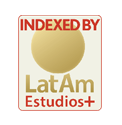Tonality and Avant- Garde
DOI:
https://doi.org/10.24215/25249215e021Keywords:
Tonality, Avant-garde, atonalism, serialism, indeterminancyAbstract
This paper introduces the general characteristics of the tonal system and its evolution during the period between the seventeenth and nineteenth centuries and the relationship of these general postulates with the proposals of rupture of the first avant-garde movements of the twentieth century for initial música and sound students at the Arts Faculty (FDA) of the National University of La Plata (UNLP).Downloads
References
Adorno, T. (1970). Reacción y progreso y otros ensayos. Barcelona, España: Tusquets.
Boulez, P. (2009). Pensar la música hoy. Murcia, España: Colegio Oficial de Aparejadores y Arquitectos Técnicos de la región de Murcia, Conserjería de Educación y Cultura de la región de Murcia, Fundación Cajamurcia.
Cage, J. (2002). Silencio. Madrid, España: Ardora ediciones.
Feldman, M. (2012). Pensamientos verticales. Ciudad Autónoma de Buenos Aires, Argentina: Caja Negra.
Fischerman, D. (1998). La música del siglo XX. Ciudad Autónoma de Buenos Aires, Argentina: Paidós.
Hobsbawn, E. (2012). La era del imperio. Ciudad Autónoma de Buenos Aires, Argentina: Crítica.
Rosen, C. (1994). Formas de sonata. Barcelona, España: Labor.
Schaeffer, P. [1966] (2008). Tratado de los objetos musicales (A. Cabezón de Diego, Trad.). Madrid, España: Alianza.
Downloads
Published
How to Cite
Issue
Section
License
The acceptance of the manuscript by the magazine means the non-exclusive cession of the property rights of the authors in favour of the editor, who allows the reuse, after publication (post print), under a license Attribution-NonCommercial-NoDerivatives 4.0 International.
According to these terms, the material can be copied and redistributed by any means or in any format as long as a) the author and original source of the publication are quoted (magazine and URL of the work), access to the license is provided and whether changes have been made is mentioned; and b) the material is not used for commercial purposes.
The cession of non-exclusive rights means that after the publication (post print) in Clang the authors can publish their work in any language, means and format; in such cases it must be mentioned that the material was originally published in this magazine. Such cession also means the authorization of the authors for the work to be collected by SEDICI, the institutional archive of the Universidad Nacional de La Plata, and to be spread in the databases that the editorial team considers appropriate to increase the visibility of the publication and its authors.
Moreover, the magazine encourages the authors to deposit their productions in other institutional and thematic archives under the principle that offering the society the scientific and academic production without any restrictions contributes to a greater exchange of the global knowledge.












 </a >
</a >












